



BPromoteAmerica’s oatingClubwithour afreshswag!Newitems Creaddedperiodically. heckoutouronline shopformore.


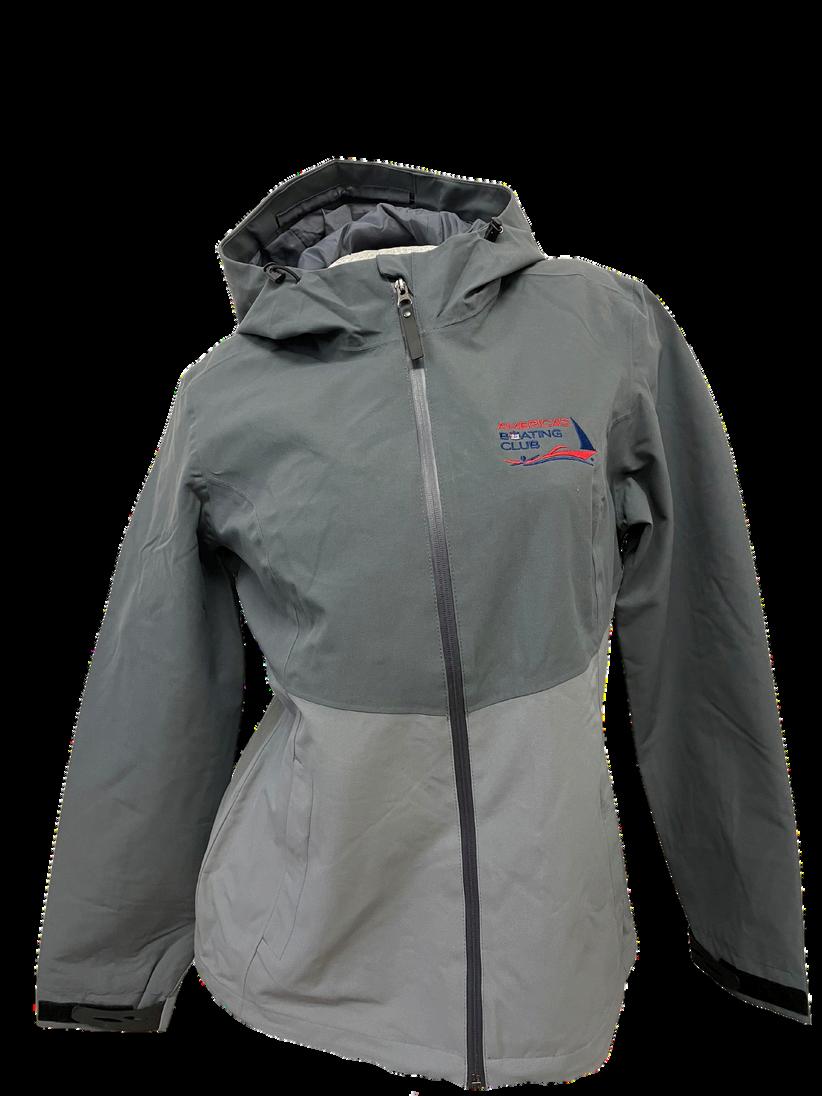
SHOP THE COLLECTION









BPromoteAmerica’s oatingClubwithour afreshswag!Newitems Creaddedperiodically. heckoutouronline shopformore.







BY CHARLES WELLS
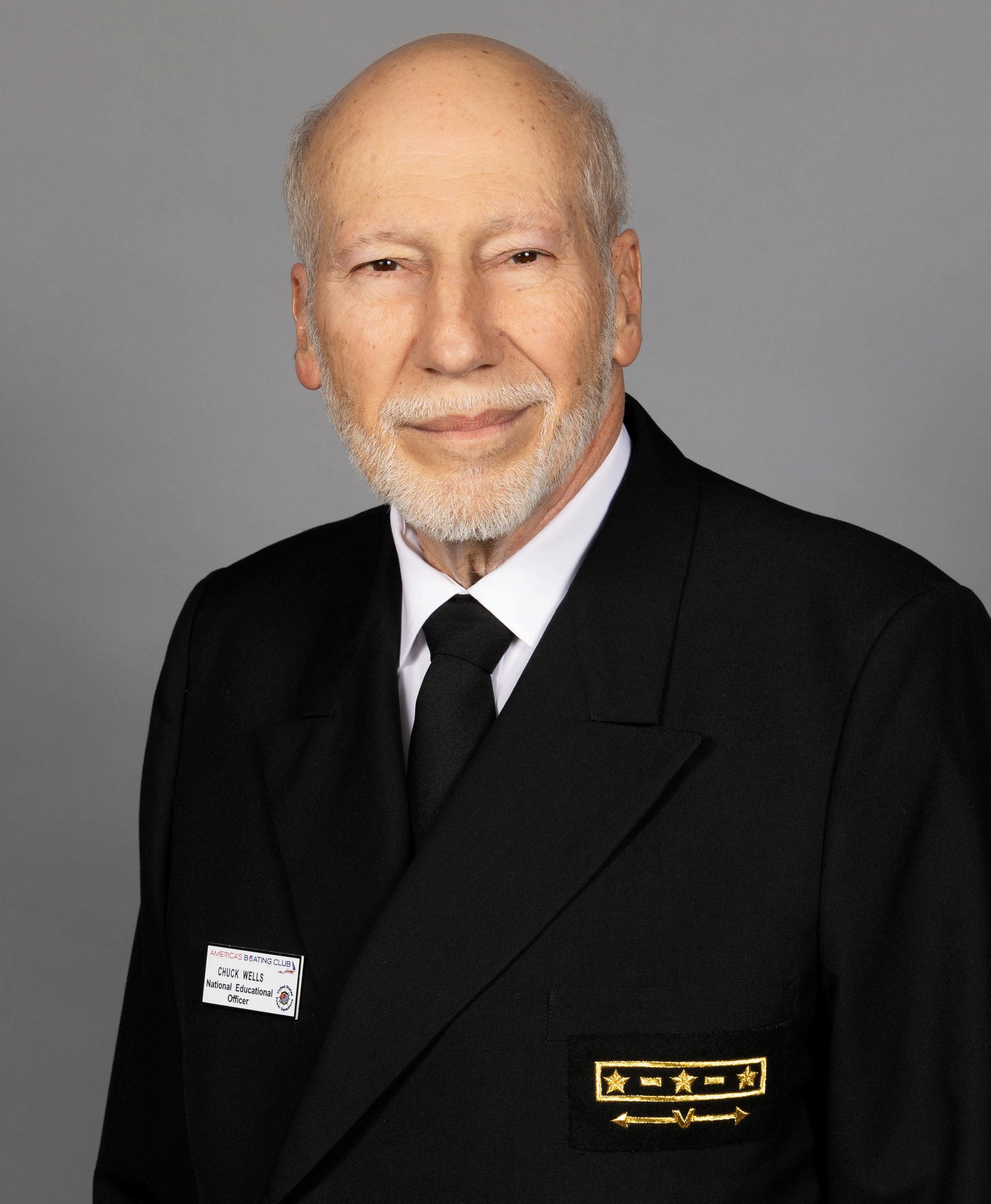
► In reviewing the 2024 U.S. Coast Guard Recreational Boating Statistics, I noticed a correlation between boating accidents and boating education. As the Coast Guard concludes, nearly 70% of boating deaths in 2024 occurred on boats whose operator did not receive boating safety instruction, while only 19% of fatalities occurred on vessels whose operator had received a boating safety education certificate
As states pass laws requiring boating education, we see the number of fatalities decrease In some instances, the reduction is significant. For example, New York’s Brianna’s Law requires all power boaters born after Jan. 1, 1978, to have taken a state-certified boating course. Since the rollout of this law in 2020, the number of accidents involving boaters who have taken a course continues to decline year over year. This is great news and should be a consideration for all boaters.
Online boating courses are proliferating. Expanding access to boater education is important Most states have review processes to ensure that the courses include state boating laws Still, it’s important to take a course from a reliable and accredited source, like America’s Boating Club | United States Power Squadrons Numerous boating publications and authorities have rated our America’s Boating Course highly
Boaters should consider more advanced courses to expand their knowledge of boating. →
→ We offer the full range of courses from marine navigation to boat handling and marine communications. Many courses are available online. In addition to the courses that we offer, the U.S. Coast Guard Auxiliary and other commercial organizations offer excellent alternatives and are available to most boaters across the country
America’s Boating Club | United States Power Squadrons is enhancing its course offerings by updating its curriculum and introducing new courses. We are also developing new courses that respond to boaters’ needs and interests. For example, we are working on a new inland boating course that covers topics affecting lake and river boating, including challenges such as river locks, dams and currents
We are also looking at new technologies We recently created a seminar on marine batteries that helps boaters understand lead-acid and lithium batteries.
America’s Boating Club | United States Power Squadrons is always looking for new members As a volunteer organization, we depend on boaters who want to help create courses and seminars that can educate future boaters If you’re interested in contributing your knowledge and services in developing new curricula, contact your local squadron today. ■
” Online boating courses are proliferating. Expanding access to boater education is important.
Vice Commander Charles “Chuck” Wells has chaired the Marine Environment, Instructor Development, Member Benefits and Navigation committees He has taught many courses and seminars but most enjoys teaching Weather and Inland and Coastal Navigation. Chuck has held leadership positions at the squadron and district levels. He also served as an instructor with the U.S. Coast Guard Auxiliary and the Maryland Department of Natural Resources and holds a US Coast Guard captain’s license He has crewed, owned and leased powerboats, sailboats and paddlecraft at home and abroad With over 50 years of experience on the water, he understands the importance of boating safety and education. Since 2019, Chuck and his wife, Deany Blades, have enjoyed living on Maryland’s Eastern Shore. Their daughter, Chuck’s former crew member, resides in New York.
You don’t have to be an expert to teach
+ THIS ARTICLE ORIGINALLY APPEARED IN THE AMERICA’S BOATING CLUB GOLDEN ISLES/26 NEWSLETTER, THE PORTHOLE
►I can think of few organizations like America’s Boating Club | United States Power Squadrons For me it combines so many things that I love: great people, fun, outdoor activities, purpose and lifelong learning I sometimes tell people we’re a social club with a curriculum
Being part of America’s Boating Club Golden Isles has indulged my passions for writing and teaching. Sure, I could write a book or get a job at a local college, but then I would be working The writing and teaching that I do now is way more fun than working
Most people think the club’s educational benefits go only one way. We offer courses and seminars. You get value by attending a class. While correct, it’s not the full story. Our club also offers people opportunities to teach. This is quite a benefit, especially for intelligent, curious individuals who have spare time, energy and motivation Teaching others has many rewards including a sense of accomplishment and purpose, but I think the opportunity to master something is the biggest benefit
If I want to really learn something, I offer to teach it. It may sound crazy offering to teach something you don’t know much about or just learned but it works. I’ve done this several times at both the graduate and undergraduate levels Because you just learned the material yourself, you know what it’s like to be a beginner You know which concepts are tricky to understand or where the students might get tripped up. Having to explain concepts to others forces you to clarify your own knowledge and identify areas where you may have gaps in your understanding. →
→ This process can lead to deeper learning and retention than simply studying the material alone.
In an article in The New York Times, “Those Who Can Do, Can’t Teach,” organizational psychologist Adam Grant talks about how the best experts sometimes make the worst educators. Grant states essentially that you don’t want Albert Einstein to be the first person you learn physics from.
He writes, “Two decades ago, I arrived at Harvard as an undergraduate excited to soak up the brilliance of professors who had won Nobels and Pulitzers But by the end of the first month of my freshman year, it was clear that these world-class experts were my worst teachers It wasn’t that they didn’t care about teaching. It was that they knew too much about their subject, and had mastered it too long ago, to relate to any basic ignorance about it.”
Social scientists call it the curse of knowledge, which exists whether you’re talking academic subjects or sports In the article Grant goes on to write, “In high school and college, I competed as a springboard diver, and I once asked an Olympian if he had a trick for learning to do three and a half somersaults. His answer: Go up in a ball and spin fast.” Not helpful.
I’ve heard similar stories about baseball legend Ted Williams, one of the best hitters ever, being a poor hitting coach There are obviously exceptions to this rule Charles F Chapman Award for Excellence in Teaching recipients Charles Wilsdorf and Mike Moye, both expert boaters, are also awesome teachers.
I recently volunteered to teach an upcoming seminar, Tides and Currents. There were lots of reasons why I volunteered, but mostly I wanted to learn more about tides and currents It’s been great fun researching the area and finding answers to all kinds of questions I keep generating
” Having to explain concepts to others forces you to clarify your own knowledge and identify areas where you may have gaps in your understanding.
EMAIL THE EDITOR READERS CAN SUBMIT LETTERS, ARTICLES AND NEWSLETTERS TO ENSIGN@HQUSPSORG ARTICLES WILL BE EDITED FOR LENGTH AND CLARITY
Just remember that you don’t have to be an expert boater to teach. You just need to be willing to dive in.
→ We all had different reasons for joining the club, including becoming a better and safer boater, meeting people and making new friends, gaining new knowledge and learning the local waterways. Hopefully, your expectations are being met in these areas.
But the value of belonging to the club does not end there. We know why people join, but why do people stay? The most engaged and involved members tell me they stay in the club for lots of reasons, including:
+ the people
+ the sense of belonging
+ the feeling of being appreciated
+ the fun
+ the sense of meaning and purpose
+ the continued opportunities to learn
+ the sense of accomplishment
+ the feeling of being challenged
Many of these benefits can come from teaching. We need more people willing to teach. This could include presenting a 20-minute topic in our America’s Boating Course, explaining how to use a particular mobile app or helping to research a topic and finding examples to use in a class It doesn’t have to mean standing in front of a class
I have not been boating that long I don’t have a degree in boating (Do they even have those?), I wasn’t in the Navy, and I don’t have a US Coast Guard license Just remember that you don’t have to be an expert boater to teach You just need to be willing to dive in. The benefits are worth it. ■
Cynthia Lamb joined America’s Boating Club | United States Power Squadrons in 2020. She lives on St. Simons Island, Georgia, and is the executive officer of America’s Boating Club Golden Isles/26.

► Members can now view photos online from National Photographer Steve Erickson of the 2025 Governing Board Meeting in Grand Rapids, Michigan
Check out all the highlights, including awards, member dinners and more.
You can also find photos from past meetings online.■
CHECK OUT MORE ON NEXT PAGE
Feb 9–15
May 16–22 Nov 12–15 Annual Meeting National Safe Boating Week BOD Meeting Myrtle Beach, SC
Feb 7–14 Annual Meeting Tampa, Fla. Raleigh, NC
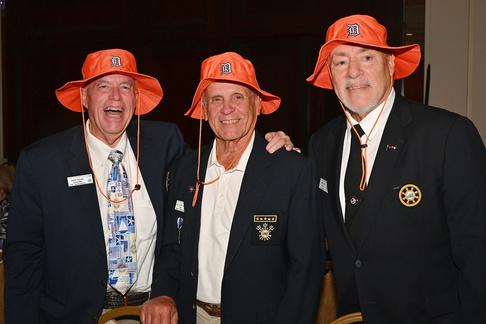

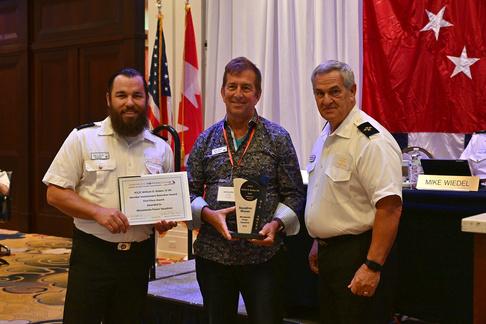
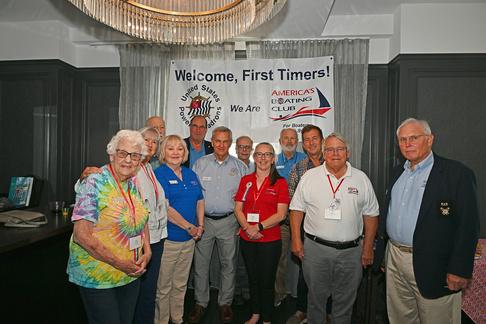
CLOCKWISE FROM TOP LEFT: REPPING FOR THE DETROIT TIGERS; DISTRICT EDUCATIONAL OFFICER TOM GEGGIE; WORKING THE ICE CREAM BAR; GRAND RAPIDS CHORUS SWEET ADELINES PERFORM; NATIONAL MEETINGS COMMITTEE MEMBERS; FIRST TIMERS WITH NATIONAL BRIDGE; CHIEF COMMANDER RALPH BERNARD PRESENTS MINNETONKA POWER SQUADRON WITH MEMBER INVOLVEMENT RETENTION AWARD



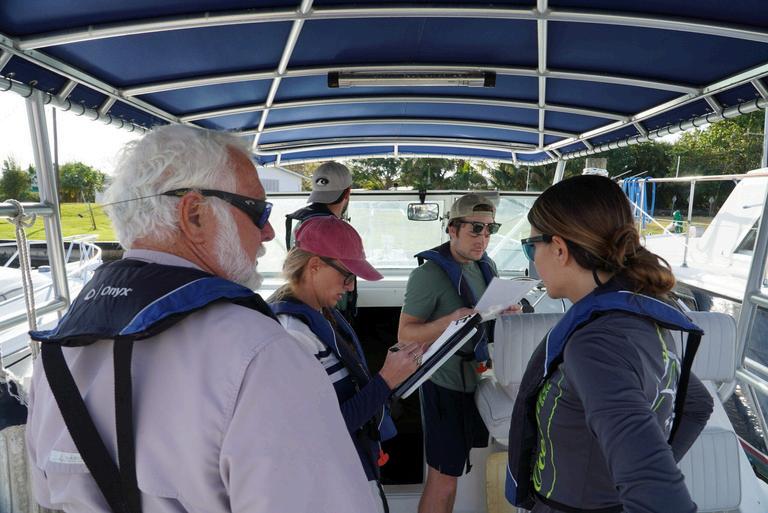
► The Chapman School of Seamanship in Stuart, Florida, has teamed up with BoatUS Foundation to offer two new National Safe Boating Council on-water training courses to promote safe and responsible boating
These hands-on courses are designed to meet the needs of powerboating beginners, experienced boat operators looking to refine their skills and marine patrol personnel who require professional-level training for vessel operation.
Intro to Powerboating is for those just starting out while Boating Essentials is the most complete course offered by Chapman. Courses are held aboard single-engine powerboats up to 26 feet in length On-water class sizes are limited to a maximum of two students per vessel, ensuring each student gets quality time underway The minimum age to participate is 11 years old, making the courses a great option for families as well –BoatUS
▲
In case you missed it, here’s what’s been happening with our clubs and squadrons on social media
District 24 members enjoyed a Kentucky River tour aboard the Bourbon Belle
America’s Boating Club Peace River/22 held a lunch cruise in June.
America’s Boating Club (Akron)/7 members took part in a kayak outing in the Nimisila Reservoir.
America’s Boating Club-Cocoa Beach/23 members organized a street cleanup on Sykes Creek Parkway before enjoying dinner together
Toledo Sail & Power Squadron/29 held a weekend rendezvous at Kelleys Island
America’s Boating Club (Virginia Beach)/5 and other clubs from District 5 partook in a summer rendezvous on Smith Mountain Lake in Virginia.

BY ALEC HARDY
+ THIS ARTICLE ORIGINALLY APPEARED IN THE SANTA BARBARA SAIL & POWER SQUADRON/13 NEWSLETTER, SIGNAL HOIST
► Our cruise to Santa Cruz Island, California, began on a Thursday with the plan to try for the Cueva Valdez anchorage on the northwest side of the island. Leaving Santa Barbara, we sailed past interesting yellow buoys, which we later determined to be a fish pen.
When we arrived at Cueva Valdez, our captain quizzed the currently anchored boats on conditions. We learned that the wind and waves had increased in the last half hour, so we decided to go farther east
We arrived at Pelican Bay in the early afternoon and were able to get in a quick snorkel and ready the skiff Our dinner was an appetizer of freshly caught scallops, ribs and a fine wine provided by the captain That night there were two other boats at the anchorage The wind and waves met us during the evening, so it was bumpy overnight.
Friday consisted of hiking, snorkeling and kayaking, and we got some great shots of the anchorage. As a diver, I can say that Pelican Bay has fun snorkeling. While there are some urchin barrens, there are still plenty of scallops, fish, sea hares, sea stars, black abalone and sheep crab. I even saw one octopus. →
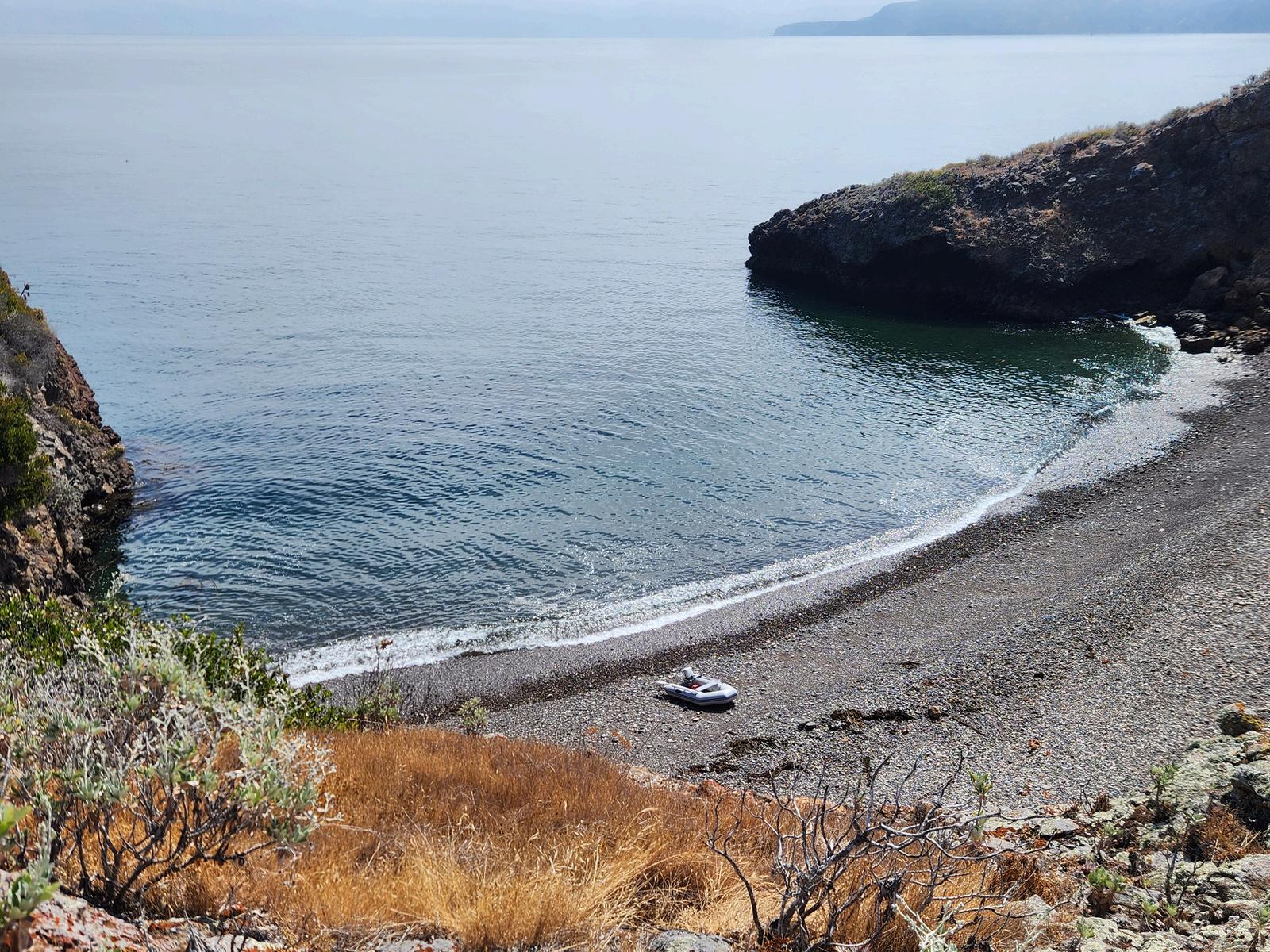
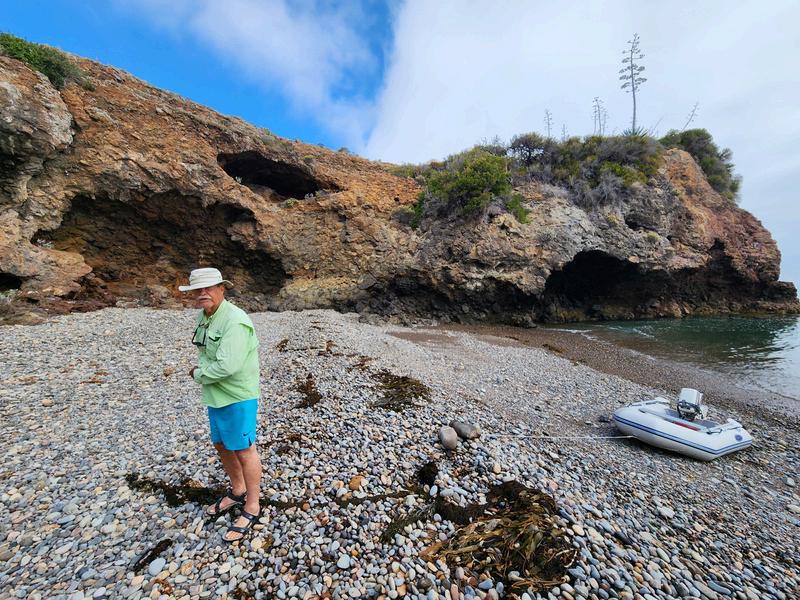

→ Once the sun passed behind the mountains, we feasted on our scallop appetizer, with the captain supplying homemade award-winning chili While not a completely calm Friday night, it was better than the night before, and sleeping was easier
Around 10:30 am the next morning, we left for Santa Barbara and encountered a good breeze from the east, which helped get us back to the harbor before 2 p.m. ■
TOP: TINKERS COVE
BOTTOM LEFT: EXPLORING THE BEACH AT TINKERS COVE
BOTTOM RIGHT: HIKING TOWARD PRISONERS HARBOR FROM PELICAN BAY
OPPOSITE PAGE: PELICAN BAY
Alec Hardy has been a member since 2022 and has served on the Cruising Committee, while actively cruising Santa Cruz. Currently, he serves as commander for Santa Barbara Sail & Power Squadron.

BY VIRGINIA JOHNS
► It was January 2000, and we were headed to Fort Lauderdale, Florida, to bring our new-to-us 1983 Amel Maramu, Libertad, home to California My husband, Dennis, was the sailor, but this 46-foot boat was larger than our current boat, the Lido 14 he had competitively sailed with his dad growing up in southern California We had hired a professional captain to accompany us on our first voyage from Fort Lauderdale to Galveston, Texas, where a truck was waiting to carry Libertad to southern California.
The captain turned out to be a lot like Captain Ron capable, unflappable, but a bit too casual, especially for this newbie sailor. I got incredibly seasick after just a few hours at sea. I was using a wristband that emitted a slight, continuous electrical pulse that I had found to be a cure for my seasickness on previous day sails. However, it was useless in the storm that hit us on this trip.
We were planning to make our first stop in St Petersburg, Florida, where an additional crew member, Joel Unger, was waiting for us But I was so ill that we stopped in Key West
Sitting in the cockpit those first few days, I tried to imagine how to tell Dennis that I was done That I could not go any farther, that this was all a mistake, and that I didn’t want him to proceed either with only himself and this captain aboard. →

→ Very dramatic, I know, but I was so depressed
Thankfully, I recovered after a few days on land I pulled out the brochure I had picked up in the chandlery in Fort Lauderdale about a boating club with a great education program that had “squadrons” in every state. Dennis promised we would look into that organization when we got home. I decided I was ready to try the next leg to pick up Joel.
Last April, Dennis and I returned to Key West this time in our RV. We rode our e-bikes around Key West and had a grand time One day we decided to head to the port and locate that infamous dock where, 25 years ago, Libertad sat for a couple days, allowing me to recover my health and senses and continue on with our dream We found it! And I teared up thinking, what if I had given up back then?
All the adventures we’ve had, the countries we’ve visited, the cultures we’ve experienced, the friends we’ve made at home and around the world what if I had missed all that? ■
LIBERTAD JUST A FEW MONTHS AFTER PURCHASE; WE HAD ALREADY REPLACED THE MAIN BOOM, MADE SAIL COVERS AND PURCHASED A DINGHY
+ THIS ARTICLE ORIGINALLY APPEARED IN THE SANTA BARBARA SAIL & POWER SQUADRON/13 NEWSLETTER, SIGNAL HOIST.
Virginia Johns has been a member of Santa Barbara Sail & Power Squadron/13 since 2003 She has held a number of positions on the bridge, including commander. She served as District 13 administrative officer for two years. As a certified instructor, she enjoys teaching Cruise Planning the most.

BY JIM GREENHALGH
+ ALL PHOTOS BY JIM GREENHALGH EXCEPT WHERE NOTED
“Warning: Abandon all hope ye who enter here.”
The sign posted at the upper entry point to the “17 Runs” section of the Hillsborough River near Tampa, Florida, is intended to discourage inexperienced paddlers from attempting this section of treacherous navigation through a maze of creeks. Without maintenance, this area can be full of downed trees requiring portaging. It’s also home to dangerous wildlife including alligators and the Florida cottonmouth. Once, this section was so bad that a small group of us took over six hours to cover 4 miles
Overall, paddling is a safe sport, but factors like weather, water, land, equipment, vessel traffic and other risks need consideration before you venture out onto the water, be it solo or with a group Paddlers can find several suggested risk assessment checklists online, and some include diagrams to help make the “go/no go” decision. Let’s look at some hazards that paddlers may face and how to mitigate risk.
The first factor that needs to be considered before launching on a paddle trip is weather →


→ Paddlers should check the local weather forecast or listen to the forecast on the marine VHF weather channels before heading onto the water or off the coast
Are the current weather conditions forecast to improve or worsen? Are the current air temperatures increasing or decreasing? Record the forecast wind direction, speeds and predicted changes. Are the winds onshore or offshore? Winds less than 15 knots are fine for most boats and paddlecraft. Winds between 15 and 20 knots are designated as Small Craft Exercise Caution, which can be OK for experienced paddlers. Winds more than 20 knots are designated as Small Craft Advisory, which will produce rough seas, and my experience has shown it’s difficult to turn a long paddlecraft into the wind or maintain a steady course
The conditions in the water need to be considered. What is the current water temperature? As water temperatures drop below 70 degrees, immersion becomes increasingly hazardous to humans, and paddlers should always dress for immersion.
Record the predicted wave height, period and direction Are the waves onshore or offshore, and how does this relate to currents? Tide and current predictions should be recorded →
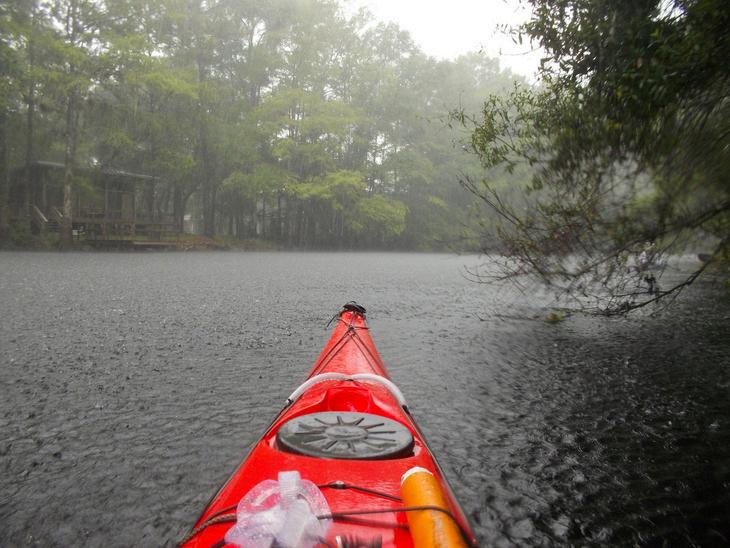
LEFT: HOLDING ON THE SIDE OF A RIVER DURING AN INTENSE THUNDERSTORM
RIGHT: PADDLING IN FOG
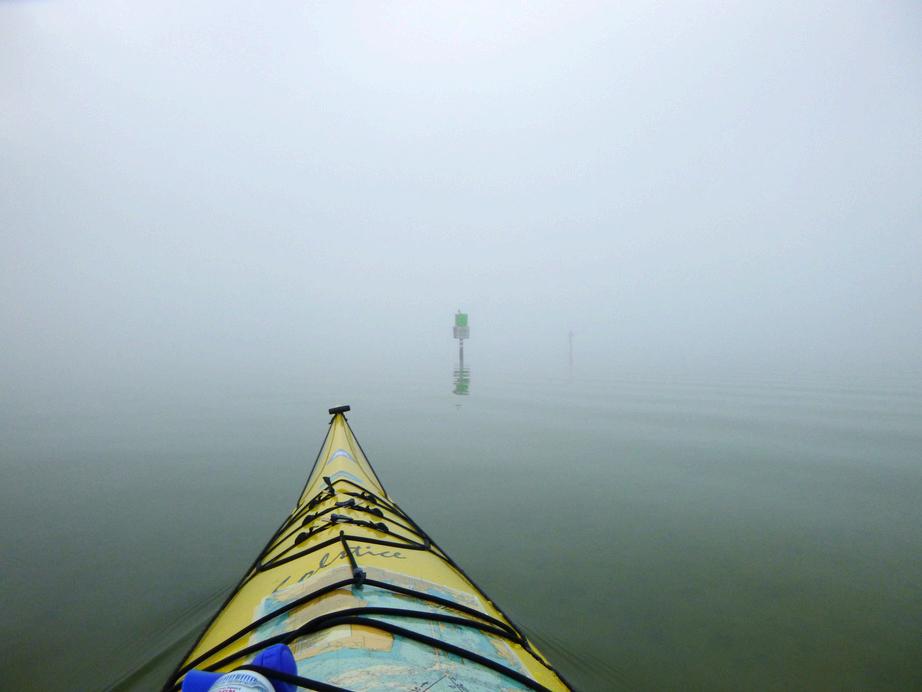
→ What are the times and heights of high and low tides, and what is the range in feet between the two? What is the direction and speed of tidal currents that might be encountered on the trip, and how does that relate to the wind and waves? Consider that most paddlecraft can cruise around 2 to 3 knots and can reach speeds of 5 to 6 knots at full power, so speed and direction vectors need to be factored into a navigation plan.
Give thought to the possibility of storms when trip planning Storm fronts are usually forecast days ahead so a paddle trip can be planned around them In many parts of the country, thunderstorms can be a daily event during certain months, so boaters should take steps to avoid them and have a plan of what to do if caught in one.
Paddlers should always consider the land and possible takeouts in the case of deteriorating weather, increasing seas, thunderstorms or other problems How far will a planned trip take you away from the safety of land? Where are the possible takeouts? Will the trip take you by areas where landing is inaccessible due to rocky cliffs, breaking surf, tidal influence or thick vegetation? Stay clear of a rocky shoreline with breaking waves. →

What type of vessel traffic might be encountered on a trip? Will you be paddling in an area with a lot of recreational boats or high-speed traffic such as powerboats or personal watercraft? Does your navigation plan include crossing major channels or waterways with commercial vessels, ships or even high-speed ferry boats? Would you be paddling in areas with tall grass or brush such as the Everglades where airboat traffic might be encountered?
While I was penning this article, two people were killed by animals in Florida within a day of each other A canoeist was killed in a lake when the canoe ran over a large alligator, and a non-boater was killed in the woods in what is believed to be the first death in Florida by bear attack While these incidents are rare, paddlers need to consider animals that might be encountered on a trip.
It is always safer to paddle in a group, and consideration needs to be given to the members, their ability and equipment Who will lead the group, and do they have the knowledge and ability to navigate the trip, make decisions and handle a situation if something goes wrong?
Do the members have the proper equipment for the planned trip, and do they have the mental and physical ability to complete the trip? →

TOP: A GROUP OF PADDLERS MAKES AN OPEN-WATER CROSSING
BOTTOM: PASSING A LARGE ALLIGATOR ON A RIVER BANK
A paddling group cannot proceed any faster than the slowest or weakest member and the main goal is always for each participant to return safely.
→ Do the members possess the skills, ability and equipment to deal with an unexpected incident? Would they be able to assist in rescue or towing another paddler in the event of an injury or exhaustion?
Consider that a paddling group cannot proceed any faster than the slowest or weakest member and the main goal is always for each participant to return safely
When preparing for a trip, paddlers should review each factor discussed in this article and consider the results of compounding factors. For example, if the weather forecast calls for winds that will cause rough seas, the risk of capsizing increases. If the water temperature is below 70 degrees, the risk level increases as a capsized paddler will be immersed in cold water.
The risk level increases again if the wind or current direction would carry the capsized paddler offshore farther from safety, or worse into breaking seas and rocks Winds opposing current will create rougher seas, further increasing the risk of capsizing
Another factor to take into account is exposure time, or the time that a paddler is exposed to a specific hazard. For example, a paddler crosses a body of water with seas running 2 feet, and the crossing takes 30 minutes. In this scenario the paddler is exposed to a certain level of risk. If we consider the same scenario with a longer crossing time of 90 minutes, the hazard of the seas has not increased, but the time exposed to that level of risk has increased three-fold. The increased exposure time elevates the risk of the paddler becoming exhausted or capsizing before reaching safety
Mitigating risk starts with education, training and experience. One of the best ways to gain knowledge and experience is to join a paddling club. Contact your local paddle sports outfitter, as many offer training and can recommend a local paddling club. →
→ Those new to paddling need to start in easy conditions, become involved in training and rescue, and gain experience before paddling into deeper, rougher waters Paddlers should always wear their life jacket and dress for immersion, as the water temperature drops below 70 degrees. As paddlers gain knowledge and experience, they need to be realistic when assessing their current skill level and equipment. Unfortunately, some overestimate their skills and get themselves into trouble out on the water.
If you will be paddling in an area with boat traffic, learn the navigation rules, use equipment and clothing for high visibility, and carry a white flashlight in case you must return after dark Carry a marine VHF or a cell phone, and leave a float plan with someone before departure
When planning a paddle trip, first review the weather forecast, tides and currents if in a coastal area; it’s best to plan the route using these factors to the best advantage. Prior to launch, consider which hazards might be encountered and consider the consequences if something goes wrong. Consider what would be the worst-case scenario. If paddling with a group, each member should be involved in risk assessment before the decision to launch is made. Is it possible to modify the trip plan to avoid some hazards and make the trip safer?
Before launch, the group, and each individual in the group, must make the “go/no-go” decision Remember that it’s best to err on the side of caution so you can always return to paddle another day ■
” Remember that it’s best to err on the side of caution so you can always return to paddle another day.
Jim Greenhalgh of St Petersburg Sail & Power Squadron/22 is a senior navigator, vessel examiner, and instructor, having taught boating safety and navigation since 1991 He draws on his vast sail and powerboating experience as a lifelong boater and avid sea kayaker. Jim leads trips for the Kayak Adventure Group, a sea kayaking club based on Florida’s west coast that he co-founded. He also wrote Navigation Rules for Paddlecraft, a must-read for all paddlers.
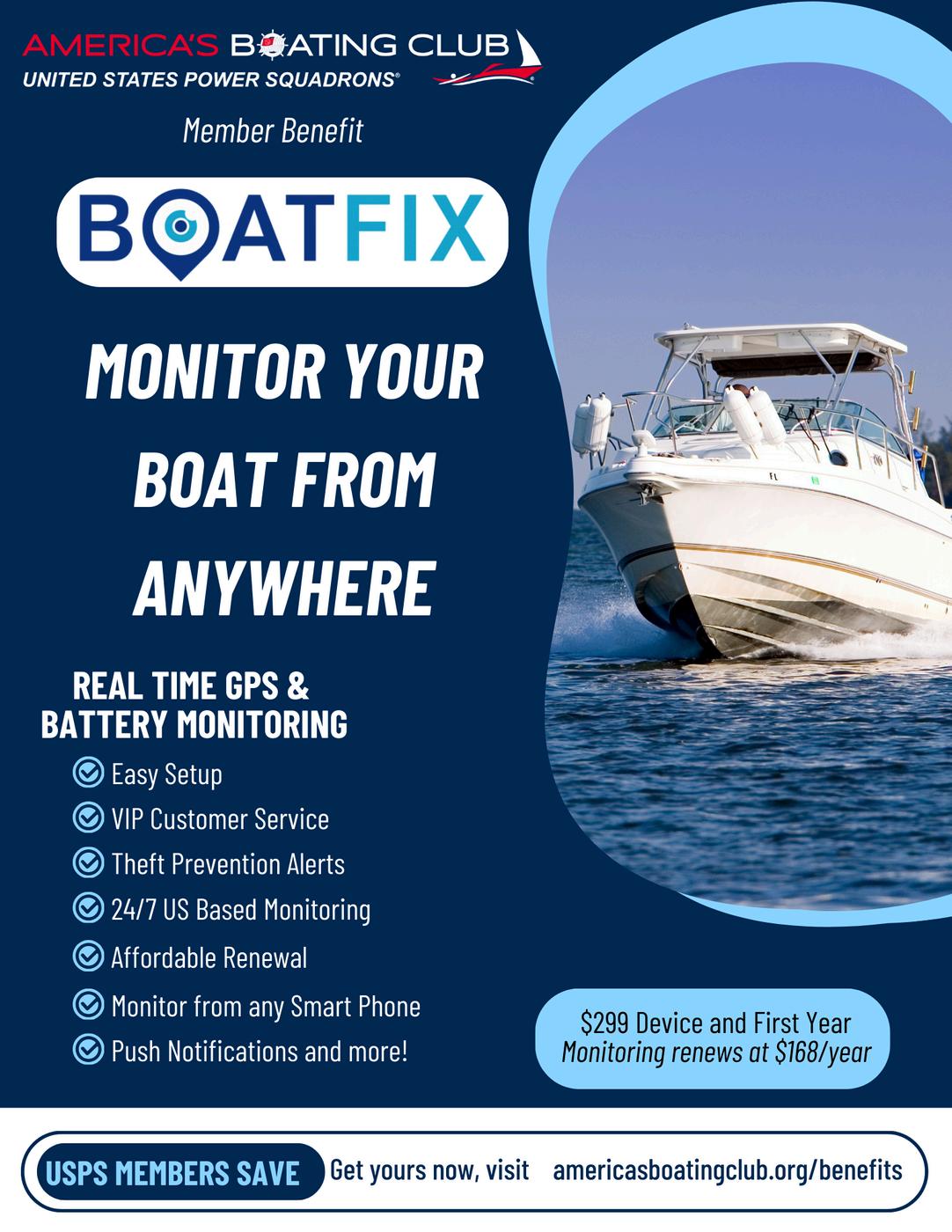
► In “Project Mayflower,” author Richard Stone describes how British World War II veteran Warwick Charlton and American financier Harry Hornblower joined forces to build Mayflower II and sail it from Plymouth, England, to Plymouth, Massachusetts. The book chronicles each man’s difficulties and the hurdles they had to overcome.
I was impressed that the replica ship was constructed using tools from the 1600s and authentic material with few exceptions. The finished vessel had the cargo and living spaces of the original Mayflower, without lighting, refrigeration or toilets. It was equipped with a diesel generator only for communications The crew navigated the Mayflower II through a seven-week voyage, surviving a heavy gale that threatened to sink it, and arrived in Provincetown, Massachusetts, on June 11, 1957, before sailing to Plymouth Harbor
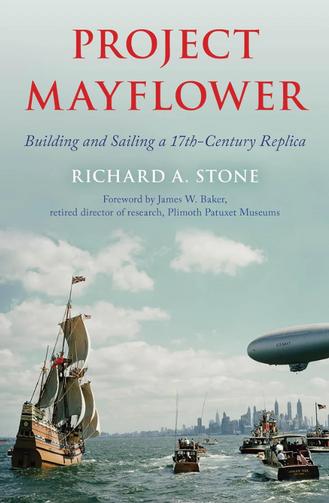
Stone relates how Warwick and Harry received applause from around the globe. Mayflower II became a major attraction and was exhibited in New York; Washington, D.C.; and Miami. More than 730,000 tourists paid to board it. This helped them raise money to settle outstanding debts for its construction and voyage.
On Sept 16, 1957, Warwick transferred ship ownership to Harry and Plimoth Plantation museum Due to the ship’s popularity, museum membership surged by 50 percent, and by 1960 the vessel had earned more than $140,000 for the museum During a routine checkup in 2013, inspectors found that Mayflower II had wood rot It took $20 million to fund the reconstruction and future upkeep The ship was taken to Mystic Seaport Restoration was completed in 2019
Ifoundthisnever-before-toldstoryofagrandadventuretobean engrossing,well-researchedandwell-documentedbook.
–PeterH.Hames
“PROJECT
MAYFLOWER: BUILDING AND SAILING A 17THCENTURY REPLICA” BY
RICHARD A. STONE

Florida squadron identifies missing waterway markers

► In the aftermath of hurricanes Helene and Milton, Anna Maria Island Sail & Power Squadron/22 member David Haddox helped the city of Anna Maria, Florida, determine which buoys and waterway markers remain in place, which markers are missing and who is responsible for replacing them.
As past commander of Anna Maria Island Sail & Power Squadron and current rear commander of the Basic Public Education Committee for America’s Boating Club | United States Power Squadrons, Haddox also chairs the city’s Planning and Zoning Board
When presenting his findings to the Anna Maria City Commission in April, Haddox said, “The mayor asked me, based on my power squadron experience, to assist him with a program to try to identify waterway markers surrounding the city of Anna Maria that are missing or off-station”
HaddoxusedtheFloridaFishandWildlifeConservation Commission’sinteractiveonlineUniformWaterwayMarkerMap toidentifythelocationsofthebuoysandwaterwaymarkerson record Clickingontheiconforeachwaterwaymarkeridentifies itspermittedlatitudeandlongitude,themessagedisplayedon themarker,thepermitnumberandmore
AlongwiththeManateeCountySheriff’sOfficeMarineUnit, squadroneducationalofficerJayWintersandcitygeneral managerDeanJones,Haddoxwentoutbyboatandvisually identifiedtheremainingandmissingmarkers.→
BY JOE HENDRICKS, NEWSPAPER REPORTER & PHOTOGRAPHER
TOP: “DANGER” MARKERS WILL BE PLACED ALONG BOTH SIDES OF THE CITY PIER HURRICANE DEBRIS FIELD WHERE DEBRIS POSES A POTENTIAL DANGER TO BOATERS
OPPOSITE PAGE: DAVID HADDOX PRESENTS A MAP INDICATING WHERE WATERWAY MARKERS ARE SUPPOSED TO BE LOCATED OFFSHORE OF ANNA MARIA.
“
Haddox created a map that indicates which waterway markers remain and which are missing; all but two are missing.
→ They also identified some markers not shown on the FWC map, including markers in Bimini Bay that mark the channel for safe navigation in and out of Anna Maria’s residential canals and five nautical dayboard markers at the entrance to Bimini Bay permitted to the West Coast Inland Navigation District The WCIND markers remain in place, but a couple are damaged
Using PowerPoint and the FWC map, Haddox created a map that indicates which waterway markers remain and which are missing; all but two of the 21 markers that should surround the city of Anna Maria are missing. Using the permit numbers listed on the FWC map, Haddox contacted the FWC and the U.S. Coast Guard to identify the permit holder for each marker in the “string of pearls” that is supposed to surround the city.
The missing markers include four Vessel Exclusion Zone markers previously located offshore of Bayfront Park As the marker permit holder, the city is responsible for replacing those markers, which prohibit motorized vessels from entering that offshore area often used by swimmers
“It is a crime to bring a vessel between those markers and shore because we don’t want people and propellers in the same water at the same time,” Haddox said “The sheriff’s office will be enforcing that once we get those markers put back.”
Haddox said a portion of the Vessel Exclusion Zone created by the initial positioning of the four waterway markers overlaps the channel leading in and out of Lake La Vista. This resulted in boaters unknowingly passing through the Vessel Exclusion Zone. According to Haddox, FWC approved repositioning the replacement markers in a manner that will remedy this concern
+ THIS STORY PREVIOUSLY APPEARED IN THE ANNA MARIA ISLAND SUN NEWSPAPER.
Most of the other markers displayed on the FWC map list Manatee County as the permit holder, and Haddox said the city would notify the county about the missing markers the county is responsible for replacing Haddox also contacted Holmes Beach Police Chief Bill Tokajer and the Holmes Beach city planner regarding missing markers in that city’s waters. →
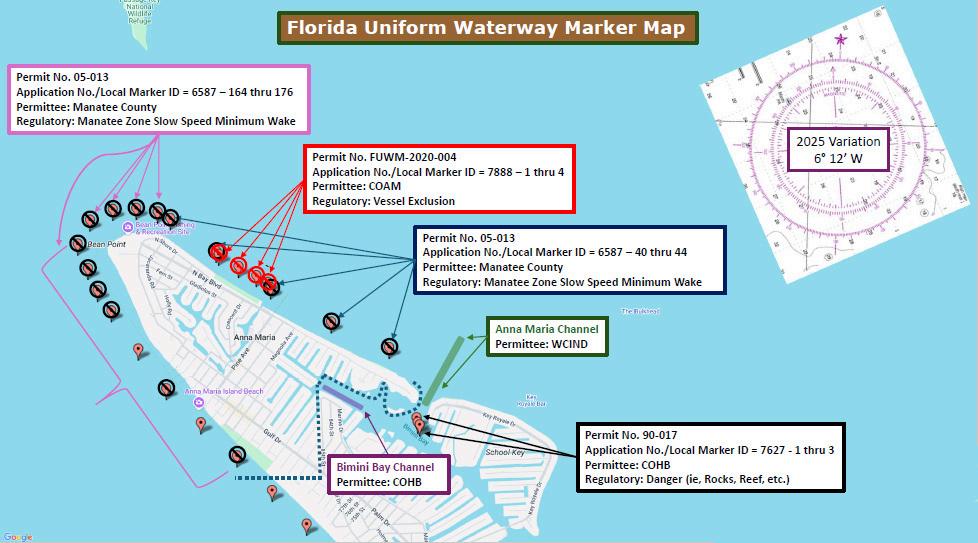
The Anna Maria City Pier sustained significant damage from hurricanes Helene and Milton, with the latter taking out a portion of the pier walkway At Mayor Mark Short’s request, Haddox also helped the city obtain FWC approval to temporarily place four “Danger” waterway markers on each side of missing City Pier walkway, where concrete pilings and other debris are submerged or partially submerged where the pier walkway previously stood.
Haddox said unlike the legally enforceable Vessel Exclusion Zones, the “Danger” buoys placed near the pier will be informational only and not subject to sheriff’s office enforcement
“They might see someone doing it and suggest that’s a bad idea, but it is violating the marked Vessel Exclusion Zone that you can actually get a ticket for,” Haddox said
Short said, “I want to thank [Haddox] and the power squadron for stepping in and helping us with this project I don’t think we have anybody on staff that even remotely would qualify to do what you guys do, and we really appreciate it.”
Per Short, a WCIND grant, to be announced in October, could end up reimbursing the cost of the project. ■
“Ø” ICONS INDICATE A MISSING WATERWAY MARKER ALL BUT TWO MARKERS OFFSHORE OF ANNA MARIA ARE MISSING THE DOTTED BLUE LINE INDICATES THE CITY LIMITS.

Despite rocky beginning, one member reminisces about what keeps her coming back

► My husband, Dave, and I joined Wilmington Sail & Power Squadron in 1963
We took boating classes for a few years before going on our first cruise with the squadron
Theyearwas1967 Therewasnoloran,noGPS,nocellphone noelectronicsatall Therewere15boatsontheChesapeake cruise,mostlysmallpowerboats Thebiggestboatwas32feet Ourswasawooden,beamy18-footblacksailboat.Itsailedlikea bathtub,andonlyonabroadreach.Wehadahardtimejust gettingtothestartatMaryland’sWortonCreekandwondered howwewouldkeepupwiththegroupfortherestoftheweek.
Wefiguredifweleftatthecrackofdawneachday,maybewe wouldgettherebeforedark.Theaveragedistancetocover eachdaywas24miles,andthatwasinastraightline,which sailboatsnevergo!OurfirstanchoragewasontheCorsica River,27milesaway,whereweweretoraft Itwasfoggyand raining,andthewindwasrightonthenose Ourenginedid notcooperate,andDavehadtocrankitbyhandaswetriedto sailourbathtub →
+ THIS ARTICLE ORIGINALLY APPEARED IN THE AMERICA’S BOATING CLUB – WILMINGTON/5 NEWSLETTER, THE LUBBER’S LINE.

→ This was only our first day, and we had a whole week to face Why were we doing this?
We arrived at the anchorage in the dark, long after everyone else, in the middle of a terrible thunderstorm. We were wet, tired and discouraged to find that all our bedding and everything else was soaked. The seam where the deck met the cabin leaked badly on the bunks. Merrimac, a powerboat from our group, saw us and beckoned us to tie alongside them. Gratefully, we huddled to the side of their boat like a baby to its mother.
I went below to make hot drinks as we were both shivering Everything was wet and depressing Soon a light came on in the powerboat, and someone on board, Betty, told us, “Come on over I have hot chocolate and popcorn ready”
We scrambled aboard with a huge lump of gratitude for their thoughtfulness They assured us we could stay rafted for the night, a great relief to us They even offered us a dry bunk, but like stubborn boaters we felt we had to stay with our little boat. The wind was howling, and the rain was relentless. I kept thinking of the 23 miles for the next day; how were we ever going to do it? →

→ Back on our boat, everything was pure disaster We shoved everything wet in the bow and hoped to be able to dry it in St Michaels the next day So we could sleep in the bunks, we taped plastic baggies with masking tape along the leaky seam and hoped they would not fall on us. As I lay there in the wind and rain that night, I vowed I would never sail without cocoa and popcorn, and I have never been without them since. Our boat was so small, and the bay seemed so big. We slept from sheer exhaustion.
→ As we headed out into the Chester River, the waves were about 2 to 3 feet. There was a lot of wind for an 18-foot sailboat that could only go about 4 knots under motor. It was going to be a long day
It took us three hours to get to the Kent Narrows Back then, the channel was long and shallowwith lots of current I remember we stopped for gas; it only cost $134 to fill the tank
”
We came through the Kent Narrows Bridge, and Eastern Bay was rough We could barely make headway, and the water was coming down the deck and through our leaky deck seams. We hobby-horsed each wave and questioned the sanity of being out there at all. The cruise boats passed us howwe wished we were aboard one of them!
Off in the distance we saw Merrimac, and we guessed soon we would be out there alone. However, Merrimac never passed us and never hailed us; it just stayed behind us like a mother duck to make sure the duckling got to port.
I’mnot saying that you must stay with the slowboats, but that kindness certainly had a profound effect on us and our feelings toward fellowboaters for the rest of our lives The crew aboard Merrimac never discussed staying out there for our sake, but we knewthey could have easily hurried up and got to port hours ahead of us That is what cruises are about: meeting friends, helping each other and making great memories
Why do we keep coming back? The friendships are what make Wilmington Sail & Power Squadron and America’s Boating Club | United States Power Squadrons special.
P.S. That winter, we bought a bigger boat. ■
That kindness certainly had a profound effect on us and our feelings toward fellow boaters for the rest of our lives.
Sandy Netting has been a boater all her life She and her husband bought their 18-foot sailboat the month they were married in 1962 In addition to the 40 years sailing the Chesapeake Bay, they have sailed in the Bahamas, the Gulf Coast and the West Indies. They have been members since 1963.



New law provides unique opportunity for Florida squadrons
► Effective July 1, 2025, the Florida Boater Freedom Act directs the Florida Fish and Wildlife Conservation Commission to create a five-year safety inspection decal program, among other things
Under the new law, Florida boats have to display stateissued registration and vessel safety inspection decals When submitting an original registration, renewal or transfer of vessel ownership to the local county tax collector, the owner must demonstrate compliance by filling out a Vessel Safety Equipment Attestation
That’s right, it’s an honor system; no one verifies that all the required equipment is on board.
On the attestation form, the owner must affirm and attest to two statements. The first statement says, “I, the undersigned, hereby affirm and attest that the vessel described above is equipped with all safety equipment required by the United States Coast Guard and applicable federal regulations for legal operation on state and federal waters”
The next statement says, “I understand that it is my legal responsibility as the owner and/or operator of this vessel to ensure compliance with all applicable maritime safety laws and regulations”
For three years in a row, Florida has tried to pass legislation mandating all boat operators take a boating safety class. So, maybe this second statement is a way of telling boat owners they need to know the rules.
Unfortunately, too many boat owners may sign this form the same way they click “I agree” to the terms and conditions on every new smartphone app they download without reading it closely
To those who see nothing but doom and gloom in this new law, I say, “When life gives you lemons, make lemonade”
This law presents the perfect opportunity to market our vessel safety checks and educational courses and seminars →
BY THOMAS
◄ AN AMERICA’S BOATING CLUB | UNITED STATES POWER SQUADRONS VESSEL EXAMINER PERFORMS A VESSEL SAFETY CHECK
“This law presents the perfect opportunity to market our vessel safety checks and educational courses and seminars.
Howmanyboatersreallyknowwhatsafetyequipmentis required?Theformdoesn’ttellthem.Whoknowswhatis requiredbetterthanourvesselexaminers?
Avesselexamhasalwaysbeenaone-on-oneeducational opportunity Ourvesselexaminersareasourceofinformation aboutchangesinrequirementswhileavesselsafetycheckis anopportunitytofindout-of-dateorworn-outequipment It’s achancetopointoutthebenefitsofnewsafetytechnology, likenon-pyrotechnicdistresssignalsandelectroniccutoff switches A15-to30-minutevisitcanensurethataboatowner canhonestlyanswerthefirstquestiononthenewform
Oureducationalcoursesandseminarsarepartofourcore mission Thelawitselfdoesn’taddresseducatingboaters,but ontheform,thestatewantsownerstoconfirmtheyknow “applicablemaritimesafetylawsandregulations”Doesn’tthis soundlikeanopportunitytomarketAmerica’sBoating Course?ThisclassfulfillsalltheNASBLAandFlorida requirementstoearnaBoaterSafetyEducationIDCardand coversmanymaritimesafetylawsandregulations.Inaddition, ourRulesoftheRoadseminarisagoodwaytolearnthe NavigationRules,whichboatersincoastalFloridaneedto know.
So,let’slookatthisnewlawpositively;let’smakelemonade. Floridasquadronsnowhaveauniqueopportunityto reinvigorateourvesselexaminationandeducationprograms. Whoknows?Itmightevennetussomenewmembersinthe process ■
Thomas E Dawson is an instructor at Cape Coral Sail & Power Squadron/22, where he leads a local waters seminar. Tom is also the author of two books, “Safe Boating in Southwest Florida: Cape Coral Edition” and “Barret Bonden’s Local Knowledge Recommended Things You Wish Someone Had Told You About Boating Here.”

► Ever tried stargazing from a boat? With fewer city lights washing out the view, the stars shine brighter, and the waves give you a gentle rhythm to relax into. It’s peaceful, it’s breathtaking, and it’s something you can only experience once you leave the shore behind.
Staring at stars from your backyard can’t compare to being out on the water No streetlights, no neon signs, no glowing buildings just clear, dark skies Being offshore gives you front-row seats to the universe’s best show
Night boating is not the same as a sunny afternoon cruise. You can’t see as far, and mistakes happen quicker. Here’s what to do before you even think about lying back to watch the stars:
1. Wear a life jacket. Everyone on board needs one. No exceptions.
2. Check your navigation lights. Red, green, white make sure every light works. Other boats need to see you, and these lights are your way of saying, “Hey, I’m here.”
3. Share your float plan.
Tell someone on shore where you’re going and when you’ll be back If things go sideways, they’ll know where to look →
+ THIS ARTICLE ORIGINALLY APPEARED IN THE SANTA BARBARA SAIL & POWER SQUADRON/13 NEWSLETTER, SIGNAL HOIST.
offshore gives you frontrow seats to the universe’s best show.
4. Bring communication gear. This means a charged phone and a VHF radio If one fails, you’ve got backup.
5. Go slow.
Visibility is limited at night, so ease up on the throttle.
6. Assign a lookout.
While some of you stargaze, one person should keep watch for other boats and obstacles
7. Use red lights.
Bring red-light flashlights or headlamps They let you see without ruining your night vision
8. Give your eyes time.
It takes about 20 minutes for your eyes to fully adjust to the dark. The longer you wait, the more stars you’ll see.
Check the lunar calendar new moons are best Watch the weather, too Clear skies and calm waters make for the best viewing Head a few miles offshore, cut the engines, drop anchor or gently drift, and keep your white anchor light on. Then kick back and let the stars take over.
+ Charts, compass, and GPS
+ Warm clothes and blankets
+ Binoculars Celestron and Orion are great
+ Star chart or stargazing app in night mode
+ Snacks and hot drinks
Finally, dust off the Weems & Plath 2102-D Star Finder and use it to know where to look no apps or screens, just classic star charts that sailors have used for decades. If you’re feeling adventurous, grab a sextant and practice taking sights on the stars and planets. It’s a fun way to connect with the old-school navigation skills that guided sailors long before GPS. ■
Keith Nunnery is commander of Las Vegas Sail & Power Squadron. He first learned about United States Power Squadrons as a kid while spending weekends and summers barefoot boating in the Florida Keys Today, Keith and his wife, Chandra, call Las Vegas home, enjoying the one-of-a-kind Lake Mead and Lower Colorado River
Lt Raymond Borchlewicz, AP Swiftwater (NY) Squadron/6 Life Member, 45 mm
P/C Sam R. Bryant, AP Lakeland (FL) Squadron/22 Life Member, 29 mm
P/C Daniel L. Burbank, AP Manchester (CT) Squadron/1 Senior Member, 23 mm
Philip M. Campbell, AP Detroit (MI) Squadron/9 Life Member, 37 mm
P/D/C Donald K. Cook, SN Manatee (FL) Squadron/22 Senior Member, 22 mm
P/C John M. Dolan III, N Richmond (VA) Squadron/5 Life Member, 33 mm
Arthur “Port” Draper Darien (CT) Squadron/2
P/C Richard E. Eppler, P Manchester (CT) Squadron/1 Life Member, 31 mm
Bettie Garnjost Delhigh (PA) Squadron/5
Richard Garnjost, SN + Delhigh (PA) Squadron/5 Life Member, 47 mm
P/C Charles W. Hinz, S Ocean City (MD) Squadron/5 Senior Member, 21 mm
P/C Frank B. Kemp, JN + Darien (CT) Squadron/2 Life Member, 38 mm
Edwin S. Koski, SN Manchester (CT) Squadron/1 Life Member, 31 mm
P/C Christopher J. Leavitt, SN Houston (TX) Squadron/21 Senior Member, 14 mm
Lt/C Elaine S. Lynch, S Northern Neck (VA) Squadron/5 3 mm
P/D/C William A. Miller, P Grand Lake (OK) Squadron/30 Life Member, 26 mm
P/Lt/C Francis P. Montuori, SN + Delhigh (PA) Squadron/5 Emeritus Member, 54 mm
P/Lt/C Thomas Mullin, AP Watchung (NJ) Squadron/4 Life Member, 36 mm
P/R/C Robert R. Palmer, SN + Richmond (VA) Squadron/5 Life Member, 44 mm
P/V/C Richard Peoples, SN Banana River (FL) Squadron/23 Life Member, 41 mm
P/C Jerry G. Simotas, SN City Island (NY) Squadron/4 Senior Member, 24 mm
Joan Stoll Detroit (MI) Squadron/9 Life Member, 32 mm
P/C Quinton P. Weaver, SN Patapsco River (MD) Squadron/5 Emeritus Member, 51 mm
Lt/C James L. Winger, SN + Mosquito Lake (OH) Squadron/11 Life Member, 36 mm
MARKS
MEMBER, 5 MERIT MARKS
MEMBER, 25 MERIT MARKS EMERITUS MEMBER, 50 MERIT MARKS
HOW TO SUBMIT FAMILY, SQUADRON COMMANDERS OR OTHER AUTHORIZED REPRESENTATIVES MAY SUBMIT REPORTS OF MEMBERS WHO HAVE CROSSED THE BAR
SUBMIT ONLINE + INDICATES ONLINE OBITUARY
LOCAL CLUBS ACROSS THE COUNTRY
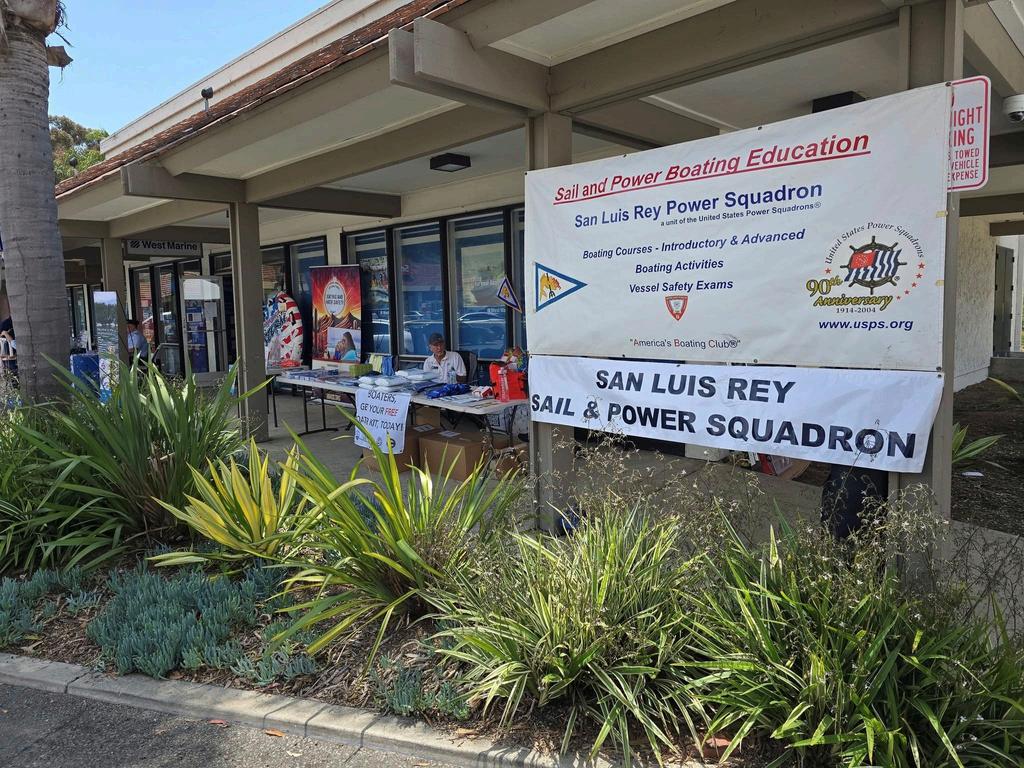
CELEBRATED NATIONAL SAFE BOATING WEEK 2025 BY DOING WHAT THEY DO BEST SERVING THE BOATING COMMUNITY AND SHARING VALUABLE BOATING SAFETY EDUCATION
► TokickoffNationalSafeBoatingWeek,America’sBoating ClubOceanside/28(SanLuisReyPowerSquadron)partnered withWestMarine,bringingtogetherboatingenthusiasts, localagenciesandthecommunityforinteractive demonstrations,freeeducationalmaterialsandon-sitesafety services
Theeventaimedtopromoteresponsibleboatingpractices aheadofthebusysummerseason AhighlightwastheBullex FireExtinguisherTrainingSimulatorpresentedbythe OceansideFireDepartment,whichgaveattendeesachance topracticehowtoproperlyextinguishanonboardfire
CertifiedvesselexaminersfrombothAmerica’sBoatingClub OceansideandU.S.CoastGuardAuxiliaryFlotilla114-01-06 conductedfreevesselsafetychecks.Boatersreceiveddecals certifyingtheirvesselshadthenecessarysafetyequipment andobtainedadviceonhowtomeetfederalandstate requirements.Familiesinneedreceivedfreechildren’slife jackets.Attendeesalsocouldenterdrawingsforboating safetygear,includingthrowrings,whistles,emergency signalingdevicesandmore –ShawnGoit

► Great South Bay Power Squadron/3 celebrated National Safe Boating Week by bringing safety to New York’s West Islip Public Library Safety officer Rodger Hess and executive officer Jeanne Braun handed out safe boating materials and tried on personal flotation devices The big hit was the boating simulator, as the kids loved the opportunity to drive a boat and not get hurt from bumping into walls and running over buoys. The squadron gave out prizes and boating coloring books. –Jeanne Braun

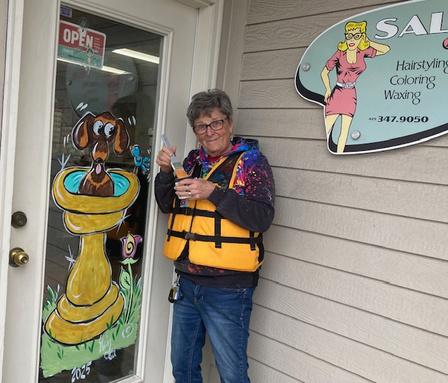
AMERICA’S BOATING CLUB OF SNOHOMISH COUNTY/16 VESSEL SAFETY CHAIR DANNY DANIELS AND PERRY MOORE TAKE A BREAK FROM VESSEL SAFETY CHECKS DURING AN EVENT SPONSORED BY A YACHT CLUB IN MUKILTEO, WASHINGTON DANNY, PERRY AND JAMES WEST PERFORMED SEVERAL VSCS FOR NATIONAL SAFE BOATING WEEK
PAST COMMANDER LINDA MARTIN OF AMERICA’S BOATING CLUB OF SNOHOMISH COUNTY/16 WEARS HER LIFE JACKET WHILE PAINTING WINDOW ART ON THE DOOR OF SALON RETRO IN EVERETT, WASHINGTON, FOR WEAR YOUR LIFE JACKET AT WORK DAY.
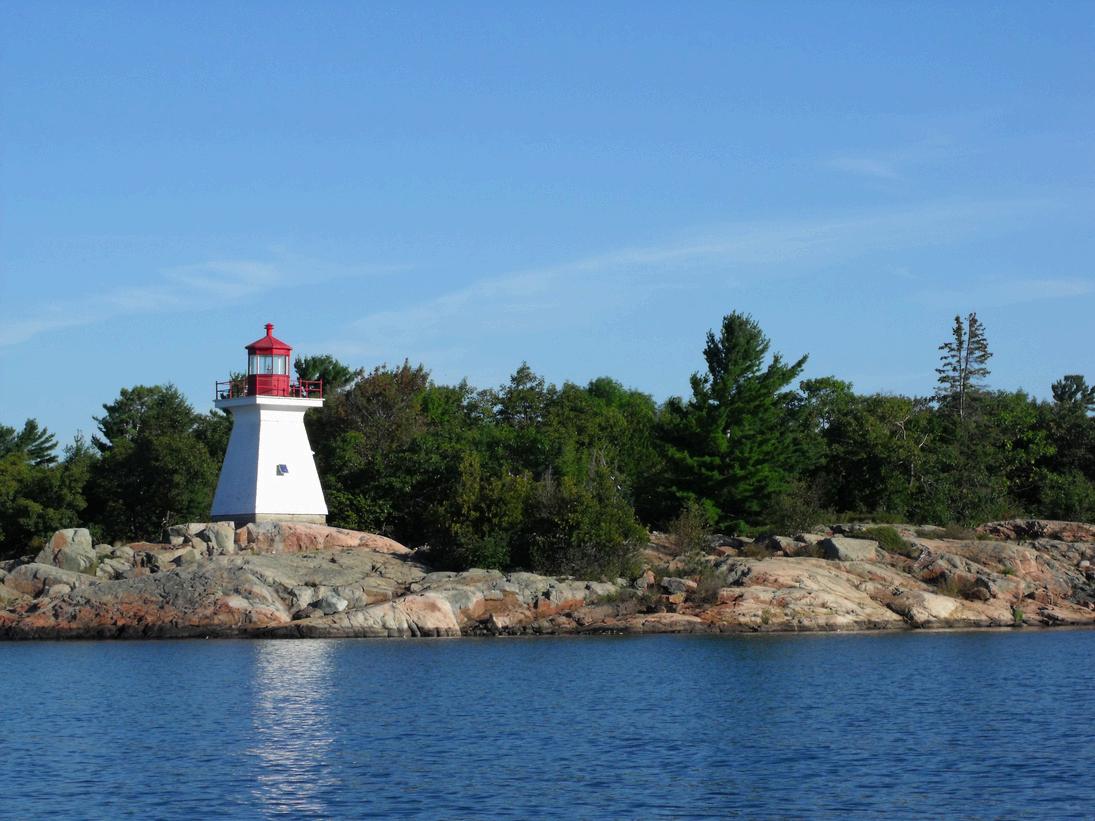
+ A VERSION OF THIS ARTICLE WAS ORIGINALLY PUBLISHED IN THE SKOKIE VALLEY SAIL & POWER SQUADRON/20 NEWSLETTER, RUNNING LIGHTS
► To get to the Killarney East Lighthouse, you must hike the trails in Killarney Provincial Park in Ontario, Canada With its beautiful sapphire lakes and white quartz ridges, this area has always been a popular destination for artists The park only has one campground to preserve its solitude and beauty and keep the area undisturbed
A contract was put together in 1850 to cover the cost of building four lighthouses on the North Channel between the northern end of Georgian Bay and Lake Superior. When the cost became too high, the North Channel lights were postponed. Finally, in 1866, the government built five nearly identical lights. Two of the lights, originally called Red Rock Light and Partridge Island, were built on bare rock. They are now called Killarney East Lighthouse and Killarney Northwest Lighthouse. They were both taken care of by one lightkeeper who would travel between the two by boat Those early lighthouses did not offer housing for the lightkeeper, so he had to build himself a shack to live in
Built in 1909, the present lighthouses are square, tapered towers mounted with octagonal iron lantern rooms A hand foghorn was used at the Killarney East Lighthouse until 1957 when a fog whistle was installed. ■
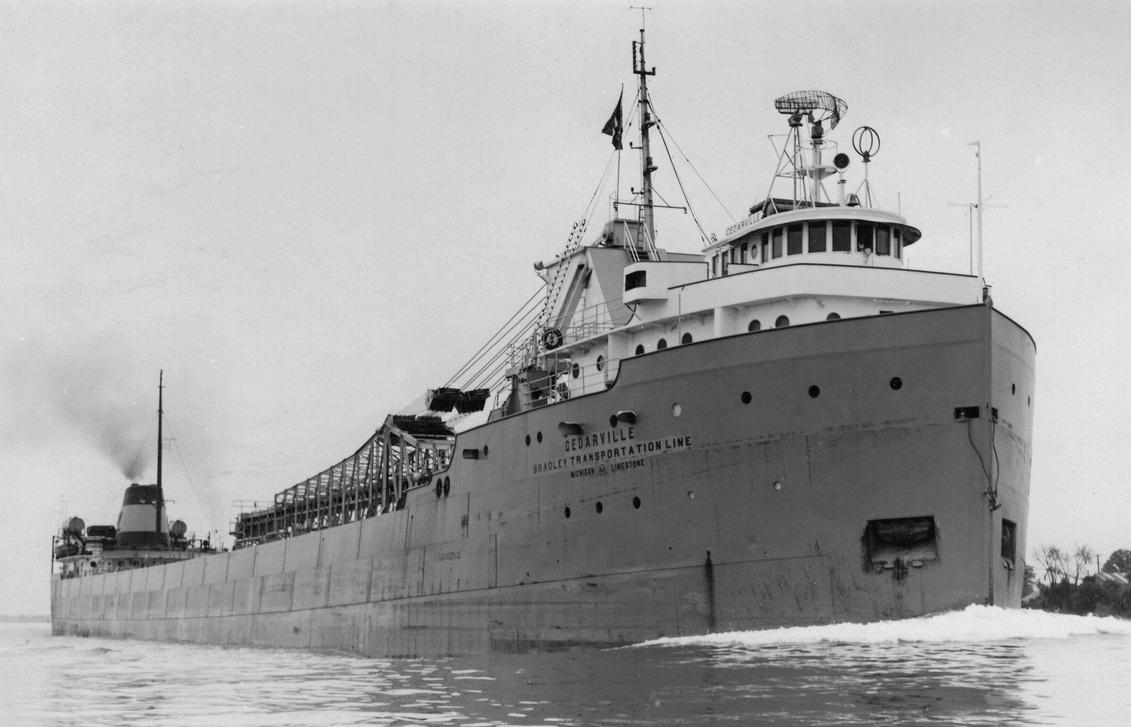
► On May 7, 1965, US Steel Corp’s 600-foot lake freighter, the Cedarville, left Rogers City, Michigan, for Gary, Indiana, with over 14,000 tons of limestone Its captain, Martin Joppich, who had been given command the previous year, had Cedarville steaming at lake speed through a thick fog to maintain schedule.
As Cedarville continued its outbound course, the dense fog worsened. Due to low visibility, two other ships had become grounded near the Soo Locks, and another had crashed into the Grays Reef Light. Despite these conditions, Capt Joppich maintained top speed of about 12 mph One mile east of the Mackinac Bridge in heavy fog, Cedarville approached the Norwegian ship Topdalsfjord
Capt Joppich initially set a course to pass Topdalsfjord starboard to starboard Topdalsfjord was the right-ofway boat because it was heading to sea, so it should have blown two long blasts on the whistle for a starboard-side pass, but this did not happen. Customarily, boats pass port side to port side. Capt. Joppich assumed that they would pass port to port, Topdalsfjord not having whistled for a starboard-side pass. He turned to starboard to pass in front of the other boat. →
BY ROBERT A. BUCHANAN
+ THIS ARTICLE ORIGINALLY APPEARED IN THE ANN ARBOR SAIL & POWER/9 SQUADRON NEWSLETTER, THE PORTHOLE.
→ Tragically, Topdalsfjord’s bow collided with the side of Cedarville Topdalsfjord sustained only minor damage, but its bow punched a hole in the side of Cedarville, causing major flooding Although neither satellite nor GPS had yet been developed, excellent radar was available so both could have seen each other through the fog VHF radio was also available for bridge-to-bridge communications
Capt. Joppich rang the engine room to stop the engines and then issued a mayday call. Within minutes of the collision, a list to port developed. Capt. Joppich then ordered water to be pumped into the starboard ballast tanks to counteract the list. A crew mate plotted a course toward a sandy beach about 2.5 miles away near Mackinaw City. But the water in the hull forced the bow down, so Cedarville rolled over and sank due to the full load of stone.
Ten of the 35 crew members of the Cedarville lost their lives that day Survivors were picked up by the German freighter Weissenburg Following an investigation by the US Coast Guard, Capt Joppich lost his license for a year
Today, travelers cross the Mackinac Bridge to head to Michigan’s glorious Upper Peninsula, Lake Michigan’s sandy beaches and the Locks. A wonderful sense of escape develops as folks enter the Upper Peninsula.
But about 2 miles east of the bridge, toward Round Island Light and Mackinac Island, Cedarville sits on the bottom, the result of confusion in the wheelhouse of both boats. The loss of life would not occur today due to satellite technology. The tragedy of Cedarville is a stark reminder of the perils of navigating the Great Lakes, especially in treacherous weather ■
TODAY, CEDARVILLE LIES ON ITS STARBOARD SIDE IN THE STRAITS OF MACKINAC, ABOUT 45 DEGREES FROM BEING UPSIDE DOWN IT’S A POPULAR DIVING SITE, BUT ITS INVERTED ORIENTATION CAN MAKE FOR A CONFUSING DIVE YOU CAN STILL SEE LOTS OF DECK EQUIPMENT AS WELL AS THE FATAL GASH
–STRAITS OF MACKINAC SHIPWRECK PRESERVE
Robert Buchanan of Ann Arbor Sail & Power Squadron/9 has sailed offshore for years and always holds a man overboard briefing before getting underway
MARINESURVEYORCaptain
JohnReichardtAccredited MarineSurveyor,SAMS,AMS, ABYCstandardscertified. CoveringallofNewEngland. MemberABYC,SAMS,USPS; 508-813-4053 captnjohn1@comcastnet captainjohnmarinesurveyors com
NAMETAGSUPPLIERLake
NormanAwardsand EngravingoffersUSPSname tagsin“ABC,”“Branded”and “Traditional”styles CallDan Splawnforacurrentpricelist at704-664-4662oremailhim atLNAwards@msncom
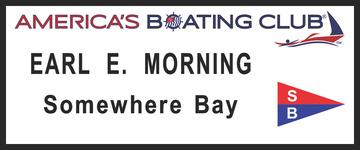

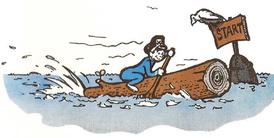
An interesting navigational challenge plus an enjoyable social activity. Discover the fun in a cruiser navigation rally. predictedlog.org CLASSIFIEDRATES
$1perword,$25minimum
Artworkis$25percolumn
inch Submitpaymentand materialstoTheEnsign, POBox30423,Raleigh,NC
27622oremail ensign@hq.usps.org
Winterdeadline: Nov. 1, 2025
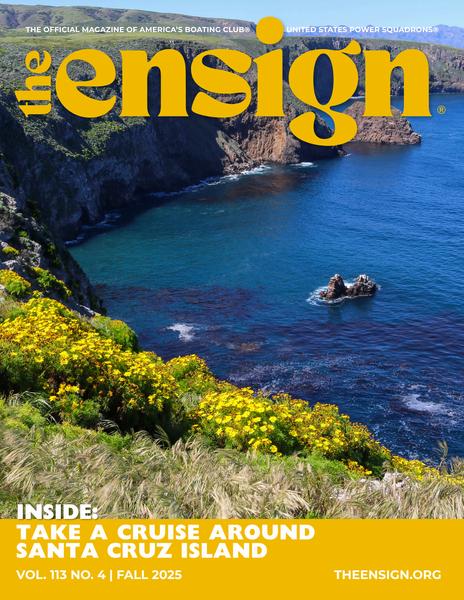

THE ENSIGN MAGAZINE
Communications Director
Yvonne Hill hilly@hq.usps.org
Deputy Communications Director
Amy Townsend townsenda@hq.usps.org
Regular Contributors
Gino Bottino, C Henry Depew, Bridget Doerner, Jim Greenhalgh, Craig Grosby, Peter Hames, Richard McCandless, Beth Schwab, John Schwab
M–Th 8 a.m.–4:30 p.m. ET Call 888-367-8777 919-821-0281 contactme@hquspsorg
Mailing address PO Box 30423 Raleigh, NC 27622
Shipping address 1504 Blue Ridge Road Raleigh, NC 27607
General information contactme@hq.usps.org ext. 230
Help desk help@uspsorg
Office Administration Director
Lena Padro padrol@hq.usps.org
Administrative Assistant
Stephanie Ford fords@hquspsorg
Accounting Supervisor
Karen Neuman jeffersonk@hquspsorg
Education education@hq.usps.org
Marketing Director
Tammy Brown brownt@hq.usps.org
Membership Supervisor
Deliah Holloway hollowayd@hquspsorg
Membership and Education Lynnda Stevens stevensl@hquspsorg
Shipping and Warehouse shipping@hq.usps.org
America’s Boating Club americasboatingclub.org
USPS member website usps.org
USPS Ship’s Store store.shopusps.org
Boat Live 365 boatlive365org
America’s Boating Channel americasboatingchannelcom
EDUCATION
America’s Boating Course online americasboatingcourse.com
All other online courses, seminars and webinars uspsonlineenrolmartcom
SUPPORT OUR MISSION
General Fund portal.americasboatingclub .org
USPS Endowment Fund Inc. uspsendowment fund
Educational Fund wwwuspsorg/national/ edfund/mainhtm
Visit your Member Portal at portal americasboatingclub org
+ Renew your membership
+ Sign up for autopay
+ Make a contribution
+ Change or add additional addresses, phone numbers and other personal information
+ More features coming online soon!
The Ensign theensignorg
America’s Boating Compass boatingcompassorg
o O n l i n e
Learn how to plan your route and follow it for a fun, safe journey with Marine Navigation from America’s Boating Club .
This online course teaches you how to chart and follow a course on the water. You’ll learn about electronic navigation using OpenCPN, paper chart navigation, and navigating coastal and inland waterways. You’ll also get a handy student guide and an online exam.

